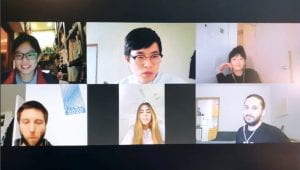One of the common questions many of the students are striving to answer is how to stay creative and hopeful during this unprecedented time. With any new experience comes an opportunity for exploration and experimentation. As the crisis persists, many of us are constantly inventing new ways to stay engaged on a daily basis. The past few weeks have been tinted with a feeling of longing for an environment that resembles the space of the studio, with its spontaneity and energy that many of us find inspiration in. The city itself was a place that harnessed this same energy, from taking the subway to walking the streets, there was always something new to be discovered. With the isolation precautions and lack of a communal creative space, students are inventing new ways to create their own forms of connectivity and inspiration.
We have explored what it means to see this shift as a challenge, not unlike any design challenge posed as an architectural question, to explore what it means to stay hopeful amidst a crisis.

With this new reality we have seen the informal turn formal. The beauty of studio life was the ease of turning to your neighbor and sliding a piece of trace towards them, or simply overhearing their music and wanting a playlist, or even just asking how they made that render so crisp. All of these questions now have to be rigidly structured and planned. We have to schedule a meeting to talk about anything and nothing. This fact poses a threat to the creative flow of ideas that many students find so necessary.
To regain this peer-to-peer connection, students have been finding creative ways to simulate the feeling of studio through virtual means. Students in the program have set up Zoom calls to create a “closeness” by leaving their video on and mic’s unmuted to simulate the environment of sitting next to one another in the studio. They don’t create the meeting with the intent of talking about something in specific but instead just talk as they would if they were working and sitting right beside each other. This has helped many students feel that connectivity we lack without the physical space allocated to similar relationships.

Another tradition that has taken a new form for our class are birthdays. There have been many March and April birthdays that we would have celebrated with a cake in studio and a dinner in the city are now celebrated online. To the right is a photo of a surprise Zoom call for Byungchan Ahn’s birthday where the students redefine what it means to celebrate life events in a shared virtual space.
In a professional sense, we have been having weekly Zoom meetings with the AAP NYC staff and the class. We meet every Wednesday to talk about whatever issues we are having to get some insight on what the university can do to help. We have talked with the AAP Director of Student Services, Jenn Michael, regarding S/U grading options and the Associate Director of AAP Connect, Scott Scheible, about internships for the summer. It has been an open platform for the whole class to discuss questions that may have arisen during the week that we may need professional input on.
All in all, the students, faculty, and staff are adjusting to a new life mediated by the digital world, with moments of discovery taking a new form. Each week poses a new challenge but also a new opportunity. We have been learning all sorts of technical skills as well as how to communicate with people in different parts of the world. These small moments of collaboration and innovation have been the light amidst the crisis. We are lucky to all be healthy and hopeful to take on this semester with resilience and adaptability. We have been able to shift our perspective to see what benefits we can gain and what relationships can be made by dealing with hard times as a collective studio and global community.
